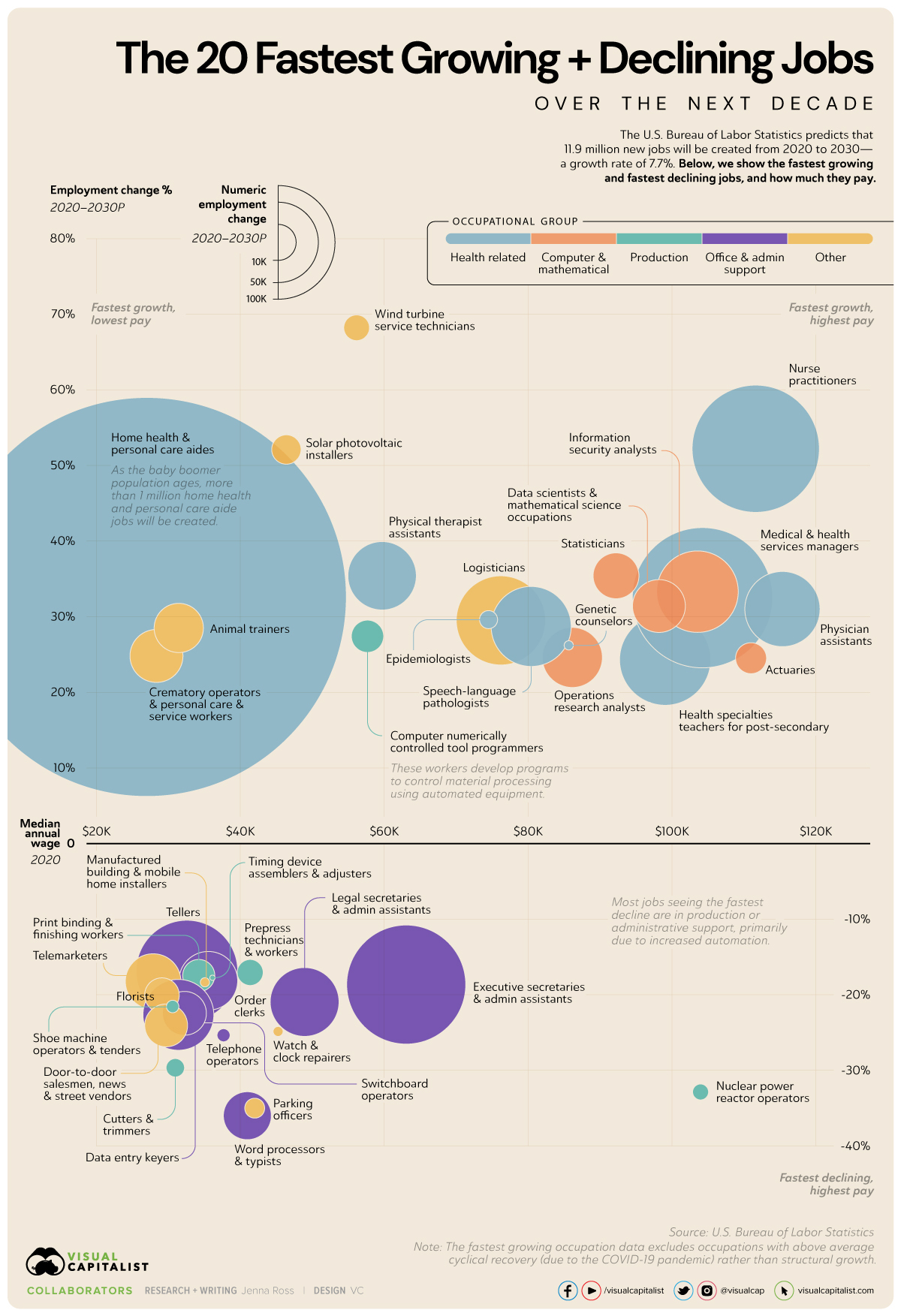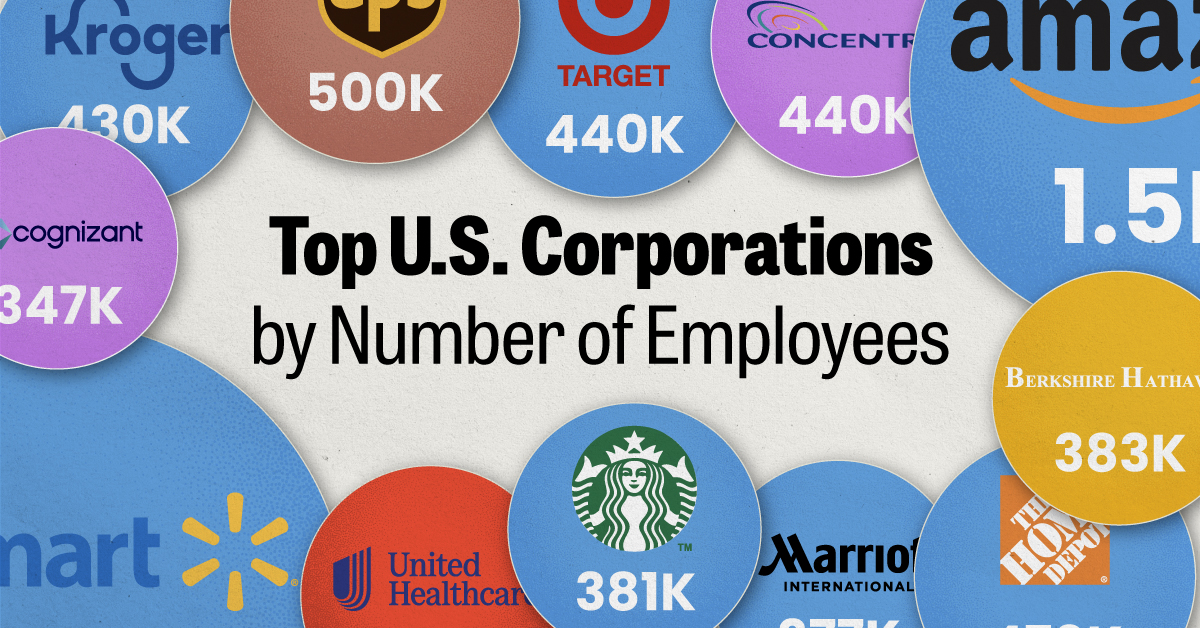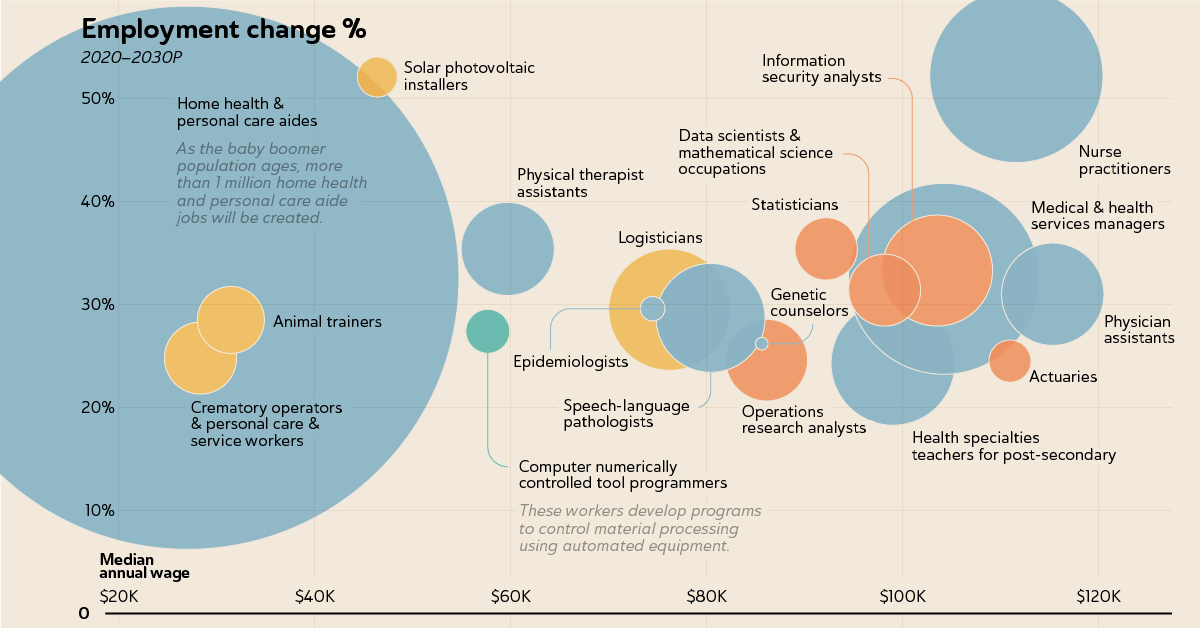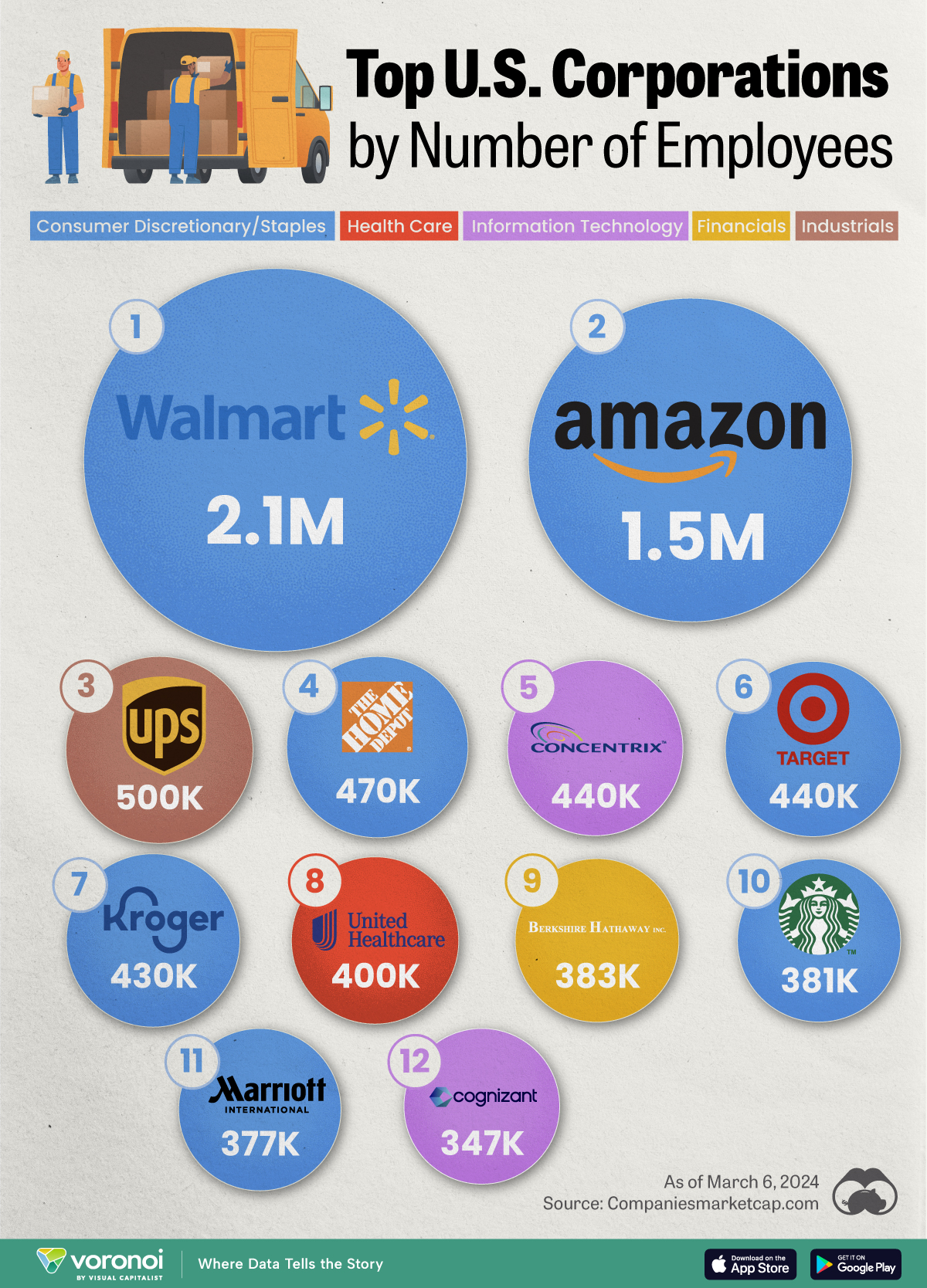Economy
The 20 Fastest Growing Jobs in the Next Decade

How is the Job Market Shifting Over the Next Decade?
The employment landscape is constantly shifting. While agricultural jobs played a big role in the 19th century, a large portion of U.S. jobs today are in administration, sales, or transportation. So how can job seekers identify the fastest growing jobs of the future?
The U.S. Bureau of Labor Statistics (BLS) projects there will be 11.9 million new jobs created from 2020 to 2030, an overall growth rate of 7.7%. However, some jobs have a growth rate that far exceeds this level. In this graphic, we use BLS data to show the fastest growing jobs—and fastest declining jobs—and how much they each pay.
The Top 20 Fastest Growing Jobs
We used the dataset that excludes occupations with above average cyclical recovery from the COVID-19 pandemic. For example, jobs such as motion picture projectionists, ticket takers, and restaurant cooks were removed. Once these exclusions were made, the resulting list reflects long-term structural growth.
Here are the fastest growing jobs from 2020 to 2030, along with the number of jobs that will be created and the median pay for the position.
| Occupation | Percent employment change, 2020–2030P | Numeric employment change, 2020-2030P | Median annual wage, 2020 |
|---|---|---|---|
| Wind turbine service technicians | 68.2% | 4,700 | $56,230 |
| Nurse practitioners | 52.2% | 114,900 | $111,680 |
| Solar photovoltaic installers | 52.1% | 6,100 | $46,470 |
| Statisticians | 35.4% | 14,900 | $92,270 |
| Physical therapist assistants | 35.4% | 33,200 | $59,770 |
| Information security analysts | 33.3% | 47,100 | $103,590 |
| Home health and personal care aides | 32.6% | 1,129,900 | $27,080 |
| Medical and health services managers | 32.5% | 139,600 | $104,280 |
| Data scientists and mathematical science occupations, all other | 31.4% | 19,800 | $98,230 |
| Physician assistants | 31.0% | 40,100 | $115,390 |
| Epidemiologists | 29.6% | 2,300 | $74,560 |
| Logisticians | 29.5% | 56,400 | $76,270 |
| Speech-language pathologists | 28.7% | 45,400 | $80,480 |
| Animal trainers | 28.5% | 17,200 | $31,520 |
| Computer numerically controlled tool programmers | 27.4% | 7,400 | $57,740 |
| Genetic counselors | 26.2% | 600 | $85,700 |
| Crematory operators and personal care and service workers, all other | 24.8% | 19,900 | $28,420 |
| Operations research analysts | 24.6% | 25,600 | $86,200 |
| Actuaries | 24.5% | 6,800 | $111,030 |
| Health specialties teachers, post-secondary | 24.3% | 58,900 | $99,090 |
Wind turbine service technicians have the fastest growth rate, with solar photovoltaic (solar panel) installers taking the third slot. The rapid growth is driven by demand for renewable energy. However, because these are relatively small occupations, the two roles will account for about 11,000 new jobs collectively.
Nine of the top 20 fastest growing jobs are in healthcare or related fields, as the baby boomer population ages and chronic conditions are on the rise. Home health and personal care aides, who assist with routine healthcare tasks such as bathing and feeding, will account for over one million new jobs in the next decade. This will be almost 10% of all new jobs created between 2020 and 2030. Unfortunately, these workers are the lowest paid on the list.
Computer and math-related jobs are also expected to see high growth. The BLS expects strong demand for IT security and software development, partly because of the increase in people that are working from home.
The Top 20 Fastest Declining Jobs
Structural changes in the economy will cause some jobs to decline quite quickly. Here are the top 20 jobs where employment is expected to decline the fastest over the next decade.
| Occupation | Percent employment change, 2020–2030P | Numeric employment change, 2020-2030P | Median annual wage, 2020 |
|---|---|---|---|
| Word processors and typists | -36.0% | -16,300 | $41,050 |
| Parking enforcement workers | -35.0% | -2,800 | $42,070 |
| Nuclear power reactor operators | -32.9% | -1,800 | $104,040 |
| Cutters and trimmers, hand | -29.7% | -2,400 | $31,630 |
| Telephone operators | -25.4% | -1,200 | $37,710 |
| Watch and clock repairers | -24.9% | -700 | $45,290 |
| Door-to-door sales workers, news and street vendors, and related workers | -24.1% | -13,000 | $29,730 |
| Switchboard operators, including answering service | -22.7% | -13,600 | $31,430 |
| Data entry keyers | -22.5% | -35,600 | $34,440 |
| Shoe machine operators and tenders | -21.6% | -1,100 | $30,630 |
| Legal secretaries and administrative assistants | -21.0% | -33,600 | $48,980 |
| Floral designers | -20.1% | -8,500 | $29,140 |
| Executive secretaries and executive administrative assistants | -18.7% | -100,600 | $63,110 |
| Manufactured building and mobile home installers | -18.4% | -600 | $35,120 |
| Telemarketers | -18.3% | -21,900 | $27,920 |
| Order clerks | -18.2% | -24,400 | $35,590 |
| Timing device assemblers and adjusters | -17.8% | -200 | $36,170 |
| Print binding and finishing workers | -17.5% | -7,300 | $34,260 |
| Prepress technicians and workers | -17.1% | -4,800 | $41,410 |
| Tellers | -16.9% | -73,100 | $32,620 |
Eight of the top 20 declining jobs are in office and administrative support. This could be cause for concern, given this category currently makes up almost 13% of employment in the U.S.—the largest of any major category. Jobs involved in the production of goods and services, as well as sales jobs, are also seeing declines.
In all cases, automation is likely the biggest culprit. For example, software that automatically converts audio to text will reduce the need for typists.
While the fastest declining jobs typically fall within the lower salary range, there is one outlier. Nuclear power reactor operators, who earn a salary of over $100,000, will see employment decline at a steep rate of -33%. No new nuclear plants have opened since the 1990s, and nuclear power faces steep competition from renewable energy sources.
Warning: Education Required
As the composition of employment shifts, it eliminates some jobs and creates others. For instance, while production jobs are declining, new opportunities exist for “computer numerically controlled tool programmers.” These workers develop programs to control the automated equipment that processes materials.
However, while many of the fastest growing jobs are higher paying, they typically also require advanced education.
| Top 20 Fastest Growing Jobs | Top 20 Fastest Declining Jobs | |
|---|---|---|
| # with median salary > $41,950 | 17 | 5 |
| # with post-secondary education required | 16 | 0 |
Seventeen of the top 20 fastest growing jobs have a median salary higher than $41,950, which is the median salary for all jobs in total. Most also require post-secondary schooling. These opportunities are replacing jobs that only required a high school diploma.
With tuition costs soaring relative to inflation, this could create challenges for displaced workers or young people entering the workforce.
Markets
Ranked: The Largest U.S. Corporations by Number of Employees
We visualized the top U.S. companies by employees, revealing the massive scale of retailers like Walmart, Target, and Home Depot.

The Largest U.S. Corporations by Number of Employees
This was originally posted on our Voronoi app. Download the app for free on Apple or Android and discover incredible data-driven charts from a variety of trusted sources.
Revenue and profit are common measures for measuring the size of a business, but what about employee headcount?
To see how big companies have become from a human perspective, we’ve visualized the top U.S. companies by employees. These figures come from companiesmarketcap.com, and were accessed in March 2024. Note that this ranking includes publicly-traded companies only.
Data and Highlights
The data we used to create this list of largest U.S. corporations by number of employees can be found in the table below.
| Company | Sector | Number of Employees |
|---|---|---|
| Walmart | Consumer Staples | 2,100,000 |
| Amazon | Consumer Discretionary | 1,500,000 |
| UPS | Industrials | 500,000 |
| Home Depot | Consumer Discretionary | 470,000 |
| Concentrix | Information Technology | 440,000 |
| Target | Consumer Staples | 440,000 |
| Kroger | Consumer Staples | 430,000 |
| UnitedHealth | Health Care | 400,000 |
| Berkshire Hathaway | Financials | 383,000 |
| Starbucks | Consumer Discretionary | 381,000 |
| Marriott International | Consumer Discretionary | 377,000 |
| Cognizant | Information Technology | 346,600 |
Retail and Logistics Top the List
Companies like Walmart, Target, and Kroger have a massive headcount due to having many locations spread across the country, which require everything from cashiers to IT professionals.
Moving goods around the world is also highly labor intensive, explaining why UPS has half a million employees globally.
Below the Radar?
Two companies that rank among the largest U.S. corporations by employees which may be less familiar to the public include Concentrix and Cognizant. Both of these companies are B2B brands, meaning they primarily work with other companies rather than consumers. This contrasts with brands like Amazon or Home Depot, which are much more visible among average consumers.
A Note on Berkshire Hathaway
Warren Buffett’s company doesn’t directly employ 383,000 people. This headcount actually includes the employees of the firm’s many subsidiaries, such as GEICO (insurance), Dairy Queen (retail), and Duracell (batteries).
If you’re curious to see how Buffett’s empire has grown over the years, check out this animated graphic that visualizes the growth of Berkshire Hathaway’s portfolio from 1994 to 2022.
-

 Mining2 weeks ago
Mining2 weeks agoCharted: The Value Gap Between the Gold Price and Gold Miners
-

 Real Estate1 week ago
Real Estate1 week agoRanked: The Most Valuable Housing Markets in America
-

 Business1 week ago
Business1 week agoCharted: Big Four Market Share by S&P 500 Audits
-

 AI1 week ago
AI1 week agoThe Stock Performance of U.S. Chipmakers So Far in 2024
-

 Misc1 week ago
Misc1 week agoAlmost Every EV Stock is Down After Q1 2024
-

 Money2 weeks ago
Money2 weeks agoWhere Does One U.S. Tax Dollar Go?
-

 Green2 weeks ago
Green2 weeks agoRanked: Top Countries by Total Forest Loss Since 2001
-

 Real Estate2 weeks ago
Real Estate2 weeks agoVisualizing America’s Shortage of Affordable Homes


















